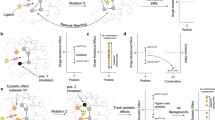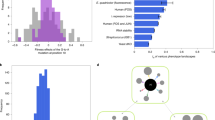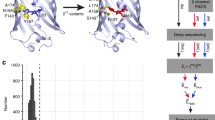Abstract
Arising from M. S. Breen, C. Kemena, P. K. Vlasov, C. Notredame & F. A. Kondrashov Nature 490, 535–538 (2012)10.1038/nature11510
An important question in molecular evolution is whether an amino acid that occurs at a given site makes an independent contribution to fitness, or whether its contribution depends on the state of other sites in the organism’s genome, a phenomenon known as epistasis1,2,3,4,5. Breen and colleagues recently argued6 that epistasis must be “pervasive throughout protein evolution” because the observed ratio between the per-site rates of non-synonymous and synonymous substitutions (dN/dS)7 is much lower than would be expected in the absence of epistasis. However, when calculating the expected dN/dS ratio in the absence of epistasis, Breen et al.6 assumed that all amino acids observed at a given position in a protein alignment have equal fitness. Here, we relax this unrealistic assumption and show that any dN/dS value can in principle be achieved at a site, without epistasis; furthermore, for all nuclear and chloroplast genes in the Breen et al. data set, we show that the observed dN/dS values and the observed patterns of amino-acid diversity at each site are jointly consistent with a non-epistatic model of protein evolution.
This is a preview of subscription content, access via your institution
Access options
Subscribe to this journal
Receive 51 print issues and online access
$199.00 per year
only $3.90 per issue
Buy this article
- Purchase on Springer Link
- Instant access to full article PDF
Prices may be subject to local taxes which are calculated during checkout

Similar content being viewed by others
References
Kondrashov, A. S., Sunyaev, S. & Kondrashov, F. A. Dobzhansky-Muller incompatibilities in protein evolution. Proc. Natl Acad. Sci. USA 99, 14878–14883 (2002)
DePristo, M. A., Weinreich, D. M. & Hartl, D. L. Missense meanderings in sequence space: a biophysical view of protein evolution. Nature Rev. Genet. 6, 678–687 (2005)
Kryazhimskiy, S., Dushoff, J., Brazykin, G. A. & Plotkin, J. B. Prevalence of epistasis in the evolution of influenza A surface proteins. PLoS Genet. 7, e1001301 (2011)
Salverda, M. L. M. et al. Initial mutations direct alternative pathways of protein evolution. PLoS Genet. 7, e1001321 (2011)
Hansen, T. F. & Wagner, G. P. Modeling genetic architecture: a multilinear theory of gene interaction. Theor. Popul. Biol. 59, 61–86 (2001)
Breen, M. S., Kemena, C., Vlasov, P. K., Notredame, C. & Kondrashov, F. A. Epistasis as the primary factor in molecular evolution. Nature 490, 535–538 (2012)
Li, W. H. Molecular Evolution (Sinauer, 1997)
da Silva, J. Site-specific amino acid frequency, fitness and the mutational landscape model of adaptation in HIV-1. Genetics 174, 1689–1694 (2006)
Fowler, D. M. et al. High-resolution mapping of protein sequence-function relationships. Nature Methods 7, 741–746 (2010)
Yang, Z. & Nielsen, R. Synonymous and nonsynonymous rate variation in nuclear genes of mammals. J. Mol. Evol. 46, 409–418 (1998)
Choi, S. C., Redelings, B. D. & Thorne, J. L. Basing population genetic inferences and models of molecular evolution upon desired stationary distributions of DNA or protein sequences. Phil. Trans. R. Soc. B 363, 3931–3939 (2008)
Rodrigue, N., Phillippe, H. & Lartillot, N. Mutation-selection models of coding sequence evolution with site-heterogeneous amino acid fitness profiles. Proc. Natl Acad. Sci. USA 107, 4629–4634 (2010)
Tamuri, A. U., dos Reis, M. & Goldstein, R. A. Estimating the distribution of selection coefficients from phylogenetic data using sitewise mutation-selection models. Genetics 190, 1101–1115 (2012)
Yang, Z. PAML 4: a program package for phylogenetic analysis by maximum likelihood. Mol. Biol. Evol. 24, 1586–1591 (2007)
Halpern, A. L. & Bruno, W. J. Evolutionary distances for protein-coding sequences: modeling site-specific residue frequencies. Mol. Biol. Evol. 15, 910–917 (1998)
Author information
Authors and Affiliations
Corresponding author
Ethics declarations
Competing interests
Competing Financial Interests Declared none.
PowerPoint slides
Rights and permissions
About this article
Cite this article
McCandlish, D., Rajon, E., Shah, P. et al. The role of epistasis in protein evolution. Nature 497, E1–E2 (2013). https://doi.org/10.1038/nature12219
Received:
Accepted:
Published:
Issue Date:
DOI: https://doi.org/10.1038/nature12219
This article is cited by
-
Deciphering polymorphism in 61,157 Escherichia coli genomes via epistatic sequence landscapes
Nature Communications (2022)
-
Senescence and entrenchment in evolution of amino acid sites
Nature Communications (2020)
-
Highly expressed genes evolve under strong epistasis from a proteome-wide scan in E. coli
Scientific Reports (2017)
-
The genomic landscape of evolutionary convergence in mammals, birds and reptiles
Nature Ecology & Evolution (2017)
-
Identification of cis-suppression of human disease mutations by comparative genomics
Nature (2015)
Comments
By submitting a comment you agree to abide by our Terms and Community Guidelines. If you find something abusive or that does not comply with our terms or guidelines please flag it as inappropriate.



